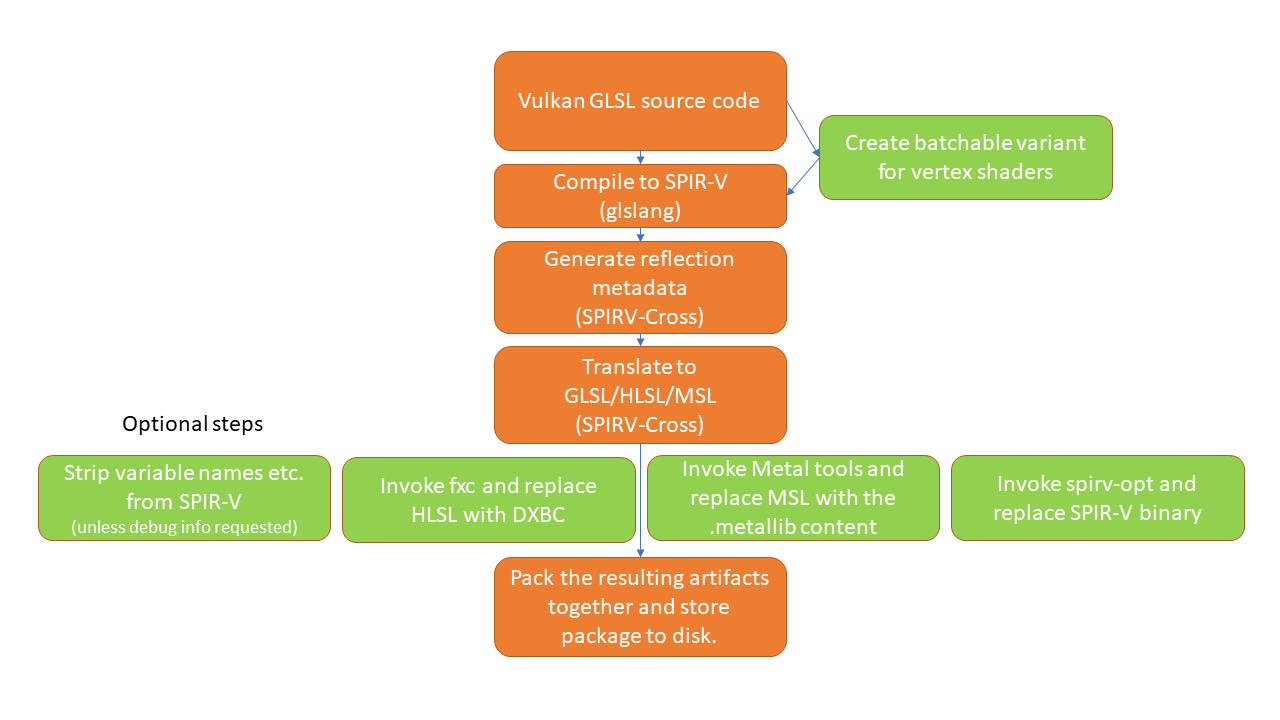
The Qt Shader Tools module builds on the SPIR-V Open Source Ecosystem as described at the Khronos SPIR-V web site. For compiling into SPIR-V, glslang is used, while translating and reflecting is done via SPIRV-Cross.
For shader code to be written once in Qt applications and libraries, all shaders are expected to be written in a single language, which is then compiled into SPIR-V. This shading language is Vulkan-compatible GLSL at the moment. This is different from what the OpenGL-style GLSL Qt 5.x expects. See the GL_KHR_vulkan_glslspecification for an overview of the differences.
Source code for other shading languages, such as GLSL, HLSL, and the Metal Shading Language, is then generated from translating the SPIR-V bytecode, together with reflection information (inputs, outputs, shader resources).
For GLSL in particular, this also involves generating multiple variants, meaning source code suitable for different GLSL versions, such as GLSL ES 100, GLSL ES 300, and GLSL 120 and 150. This is then packed into serializable
QShader container objects, typically stored on disk as .qsb files. The Qt Rendering Hardware Interface consumes QShader instances
directly, picking the shader source or bytecode that is best suited for the graphics API used at run time. A QShader object is typically deserialized from .qsb files
shipped with the application or Qt itself in the Qt Resource System.
Some platforms provide the option of compiling shader source code to an intermediate format similar to SPIR-V. This involves running platform-specific tools. With Direct 3D, the qsb tool provides
the option to invoke the fxc tool from the Windows SDK once the HLSL source code has been generated. It then replaces the HLSL source code with the
DXBC binary generated by fxc. This can have a positive effect on applications' runtime performance since they no longer need to do the first phase of compilation (HLSL
source to DXBC) themselves. For macOS and iOS, the XCode SDK provides similar tools. The
downside of this approach is that running these tools is only possible on their respective platforms. Therefore, this is best suited for use in combination with qsb's CMake integration since doing shader conditioning at
application build time implicitly comes with the knowledge needed about the target platform and what platform-specific tools can be invoked.
The following diagram describes the steps that happen during an invocation of the qsb tool:

The main components of the Qt shader conditioning system are:
qsb command-line toolqsb toolqsb tool)
Application developers typically work with custom shader code in Qt Quick scenes that have one of the following:
For example, consider the following QML snippet:
ShaderEffect { width: 100; height: 100 fragmentShader: "myeffect.frag.qsb" }
Here the fragmentShader URL refers to a .qsb file relative to the .qml file's location. The
application is expected to ship myeffect.frag.qsb next to the .qml file. To generate that file from the Vulkan-style GLSL source (which itself does not need to be shipped
with the application), the application must use the qsb tool either directly or via CMake.
Qt Quick 3D uses the Shader Tools module directly to perform shader conditioning at run time. In addition, it provides solutions for pre-generating shaders for materials at build time, in case a runtime dependency to shader
compilers and other tools is not seen ideal. In either case, developers don't need to work directly with the qsb tool since it's encapsulated by the Qt Quick 3D's own framework and tools.

As part of the free Business evaluation, we offer a free welcome call for companies, to talk about your requirements, and how the Felgo SDK & Services can help you. Just sign up and schedule your call.
Sign up now to start your free Business evaluation:

